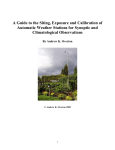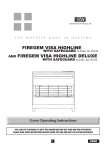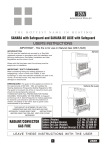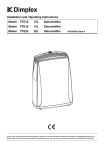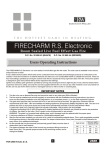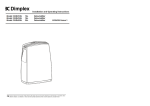Download 3000W PIR LIGHT CONTROLLER
Transcript
C Dusk Time D Installation Lens Mask IMPORTANT – Switch off the electricity at Restrict long detection After choosing a suitable location (see previous section) install the unit as follows: Installation & Operating Instructions 3000W PIR LIGHT CONTROLLER Cat No. DX4131 – White Restrict short detection Restrict RHS detection Restrict LHS detection Parts included • PIR Sensor unit. • Instruction manual. Please keep safe for future reference. • Accessory Pack. Tools and parts needed • • • • • 3 core flexible cable. Electric/hand-held drill & bits. Terminal or Electricians screwdriver. Large slotted/philips screwdriver. Wire cutters. This product is suitable for wall or ceiling mount. Lighting loads connected must not exceed maximum 3000W filament/incandescent or 500W fluorescent/ low energy lighting. Do not attempt to install during wet weather, if you are suffering from nausea or dizzy spells or on medication with similar side effects. If in any doubt, consult a qualified electrician. Not suitable for use with discharge lighting. Introduction The DX4131 utilises passive infrared technology to detect heat radiation of moving human bodies. Upon detection, the attached lighting load will illuminate for a user-determined time period. An integral daylight sensor ensures night-only operation. Important Information: Light Pollution and Considerate Lighting Please be aware of the annoyance over-lighting an area can cause to your immediate neighbours. Light pollution caused by incorrectly installing a unit or over-lighting an area can be limited by carefully considering the location and position of your unit before installation. The light spread on all halogen floodlights can be reduced by angling the floodlight downwards on the mounting bracket. This will also concentrate the light on your property and limit the potential inconvenience of the light shining into your neighbours windows etc. Please see Selecting a Location for information on choosing the optimum location for any security light controlled by this unit. B A Top View 180º Less sensitive More sensitive Side View 2.5m 12m the fuse box by removing the relevant fuse or switching off the circuit breaker before proceeding with the installation. Selecting a location The motion detector has a number of detection zones, at various vertical and horizontal angles as shown (see diagram A). A moving human body needs to cross/enter one of these zones to activate the sensor. The best all-round coverage is achieved with the unit mounted at the optimum height of 2.5m. Careful positioning of the sensor will be required to ensure optimum performance. See diagram A detailing detection range and direction. The unit will not detect through glass (e.g. in a glazed porch). The detector is more sensitive to movement ACROSS its field of vision than to movement directly TOWARDS (see diagram B). Therefore position the unit so that the sensor looks ACROSS the likely approach path. Avoid positioning the detector where there are any sources of heat in the detection area (extractor fans, tumble dryer exhausts etc.) including opposite any other light sources such as other security lights. Reflective surfaces (ie pools of water or whitepainted walls) and overhanging branches may cause false activation under extreme conditions. During extreme weather conditions the motion sensor may exhibit unusual behaviour. This does not indicate a fault with the sensor. Once normal weather conditions return, the sensor will resume normal operation. Light pollution To reduce the risk of light pollution, consider the following when installing the any lights controlled by this unit. Position the light to ensure that the light emitted does not encroach onto neighbouring properties. Angle the floodlight downward to focus the illumination onto the ground, not into the sky. Consider using a lower wattage bulb (200W/300W for a 500W floodlight) to save energy and reduce high light output if not required. The unit is suitable for connection to a 230 V ac 50Hz electricity supply. It is suggested that 3-core round flexible cable of 1.5 sq. mm gauge is used. An internal switch should be installed to switch the power to the unit ON & OFF. This allows the sensor to be easily switched off when not required or for maintenance purposes. This product is designed to be mounted on walls or under eaves, see diagram E. The sensor can be rotated through 180 degrees to direct detection where required, consider your location carefully before installation. Remove the unit from its packaging. Unscrew the wiring box fixing screw shown on diagram F. This screw is captive, do not fully remove. Detach the wiring box from the Sensor body. Using the wall plate as a template, mark the position of the fitting holes. Drill the holes. Insert the wall plugs into the holes. PIERCE & PASS THE CABLE(S) THROUGH THE GROMMET(S) BEFORE PROCEEDING. It is recommended that the grommet is pierced with a screwdriver to ensure a better seal. Attach the mounting plate to the wall using screws provided. Do not overtighten the mounting screws as this could damage the unit. If using a power screwdriver, use the lowest torque setting. This unit features an installation aid. Simply hang the Sensor onto the wall plate by use of the clip arrangement on the wall plate. See diagram H. This allows you to use your hands to hold the screwdriver, and install the incoming cables with ease. Connect the incoming and outgoing cables as follows. Connection Connect the mains supply cable to the terminal block on the unit as follows (see connection diagram): NEUTRAL (Blue) N EARTH (Green/Yellow) LIVE (Brown) L Connect the cable from the lighting load to the terminal block on the unit as follows (see connection diagram): NEUTRAL (Blue) N EARTH (Green/Yellow) LIVE (Brown) L1 Ensure that all connections are secure. Ensure the terminal block is attached to its mounting posts in the sensor body. Un-hook the sensor unit from the wall plate and re-attach to the wall plate box as follows:Ensure no wires are trapped. Align the sensor centrally over the wiring box and attach the top edge of the sensor to the wall plate. See diagram I. There will be an audible click indicating that the top clips are located into the wall plate. Slowly rotate the sensor body downwards and ensure no wires are trapped, the lower edge of the unit will locate into the wallplate. Fully tighten the fixing screw. See diagram F. Installation is complete. Connection Diagram Isolation switch Mains supply Load Manual Override Mode The light can be switched on for longer time periods by use of the Manual Override Mode. This can be activated at night by using the internal wall switch or circuit breaker. Switch the isolation switch twice (off/on, off/on) within 2 seconds. The unit will now illuminate continuously until dawn or until it is switched back into Auto Mode. To switch the unit back into Auto Mode, switch isolation switch off/on once within 1 second. The unit will return to Auto Mode. Masking the Sensor Lens To restrict the sensor coverage, preventing detection in unwanted areas, mask the sensor lens using the masks provided in the accessory pack (see diagram H). For your information, the top section of the lens covers long range detection, the bottom covers short range. Similarly the left and right lens sections cover the left and right detection areas respectively. E Check the lamp. If the lamp has failed, replace. Ensure that the lamp is seated correctly in the lampholder. Please note that the unit will not detect through glass.(e.g. in a glazed porch). • The PIR sensor will not operate at night. 180 degree rotation of sensor head ensures accurate detection control Operation and testing Walk Test Procedure The detector will adjust vertically through 180 degrees Adjust the detector to point at the desired elevation. Angling downwards will limit forward looking range. Set the two adjustment controls on the underside of the unit (diagram C) to the following positions: TIME - Fully anti-clockwise DUSK - Fully clockwise The unit will now operate during daytime as well as at night, illuminating the lamp for approx. 5 seconds each time detection occurs. This allows testing to be carried out to establish the best position for the sensor. The lamp will immediately illuminate as the unit goes through its "warm-up" period. After approximately 1 minute the lamp will extinguish. Try to remain outside the detection area during the warm-up period. Walk across the detection area approx 5 metres from the unit. As you cross a detection "zone" the lamp will illuminate. Now stand still until the lamp extinguishes (this should take approx. 5 seconds). Start moving again. As you cross each "zone" the lamp will illuminate. Repeat the above, walking at various distances and angles to the unit. This will help you to establish the detection pattern. If the detection area is too small for your requirements, try angling the sensor head up. This will increase the coverage distance. Angling the head downwards will reduce the range should a smaller coverage area be required. Setting Up for Automatic Operation When walk tests are complete, the unit can be adjusted for automatic operation: The TIME setting controls how long the unit remains illuminated following activation & after all motion ceases. The minimum time (fully anticlockwise) is approx. 5 seconds, whilst the maximum time (fully clockwise) is approx. 18 minutes. Set the control to the desired setting between these limits. The DUSK control determines the level of darkness required for the unit to start operating. The setting is best achieved by the procedure below: Set the DUSK control knob fully anti-clockwise. The unit will now start operating at dusk. If you require the light to activate earlier, wait until the ambient light level reaches the level of darkness at which you wish the lamp to become operative, SLOWLY (a small step at a time) rotate the control in a clockwise direction until a point is reached where the lamp illuminates. Leave the control set at this point. At this position, the unit should become operative at approximately the same level of darkness each evening. Observe the operation of the unit. If the unit is starting to operate too early (ie. when it is quite light), adjust the control slightly anti-clockwise. If the unit starts to operate too late (ie. dusk), adjust the control slightly clockwise. Continue to adjust until the unit operates as desired. The level of ambient light in the area may be too bright to allow operation at the current DUSK setting. During the hours of darkness, adjust the DUSK control slowly clockwise until the lamp illuminates. Refer to previous section for more details. • Unit activates Adjust the setting anti-clockwise to lower the level of ambient during the light required for activation. daytime Unit may be poorly located. See • PIR previous section – ‘Selecting The coverage is poor/sporadic Location’ and re-locate the unit. Wall mount F Ceiling or eave mount G PIR sensors are influenced by climatic conditions. The colder the ambient temperature, the more effective the sensor will be. You may need to make seasonal adjustments to the sensor head position to ensure trouble-free operation all year round. Technical specifications Wiring box fixing screw H • Detection range varies from day to day Detection Range: Up to 12 metres Detection Angle: 200º Installation aid. clip main body onto wall plate for easier wiring Power Supply: 230 V AC ~ 50Hz Maximum Switchable Load: 3000W filament/incandescent lighting (e.g. 6 x 500W halogen floodlights) 500W Fluorescent or Low Energy lighting Extra view shows details of clip arrangement I 2. Rotate sensor body down and “click” lower edge into place Not suitable for use with SON or other discharge lighting 1. Align top edge and click Fully tighten sensor fixing screw Troubleshooting guide Problem • Lamp stays ON all the time at night. Solution Cover PIR lens with a thick cloth. If the light turns out, check detection area for heat or reflective source. If the light stays on, check wiring. See Section 3. • PIR keeps activating for no reason (at random). Turn the unit off at the isolation switch. Turn the unit back on again after 30 seconds. Leave for approximately 18 minutes. If light activates, check area for false activation from heat, wind or reflective source. • PIR sensor will not operate at all. Check that the power is switched ON at the isolation switch. Turn OFF the power to the unit and check the wiring connections. Time On Adjustment: 5 seconds – 18 minutes Dusk Level Adjustment: Day & night or night only operation Environmental Protection: IP55 (suitable for outdoor use) Conforms to Directives: Conforms to latest directives. 5 Year Guarantee In the unlikely event of this product becoming faulty due to defective material or manufacture within 5 years of the date of purchase, please return it to your supplier in the first year with proof of purchase and it will be replaced free of charge. For years 2 to 5 or any difficulty in the first year telephone the helpline on 0844 879 35 87. For assistance with the product please contact:- HELPLINE 0844 879 35 87 [email protected] For a product brochure please contact: GDC Group Ltd Millbrook House, Grange Drive Hedge End, Southampton SO30 2DF Tel: 0844 879 35 87 Fax: 0844 879 35 82 email: [email protected] ROI: 01 842 4833 67.058.499 (issue 1)



